Jurassic World, out tomorrow, is getting praise for its awesome dinosaur action. But it’s also getting a lot of criticism for its characters, especially the way it handles Bryce Dallas Howard. We talked to director Colin Trevorrow about how to make a monster movie in the Age of Sharktopus.
Spoilers ahead...
How do you deal with the fact that we’re living in the age of Sharktopus? There are so many CG monster movies out there, and we’re so used to all the tropes?
I feel like our movie is aware of that, hopefully not hyper-aware of it, but it acknowledges it. And yet I also think that monster movies are fun, and we enjoy these things for a reason. So I wanted to find a way to balance that, to recognize that it’s inherent in this story we’re telling, that people are going to this theme park because they want to see that.
You can kind of see that moment in the film, when the crowd is watching the Mososaurus finish off the shark, and it’s like they’re at an MMA fight. They’re all cheering, because they want that carnage. There’s something really interesting about how human beings just want to see animals tear each other apart, maybe because we can’t do it. I thought there was at least something in there where we could be the thing that we’re talking about, and hopefully get away with it.
Monster movies are constructed around set pieces where you have people at a lake and then a monster comes out and eats them. I feel like this movie does a lot to shake that up. Did you think about how to break up the structure? You reveal the Indominus Rex really early in the movie, instead of making us wait for it.
Somewhat early. Definitely earlier than we [showed the main dinosaurs] in the previous ones. I knew they were going to show it in all the trailers, no matter what they promised. Steven [Spielberg] had the luxury of making a movie where there was one trailer, where you didn’t see any dinosaurs. So the level of joy and surprise is very different. But we did try to certainly show its consequences.
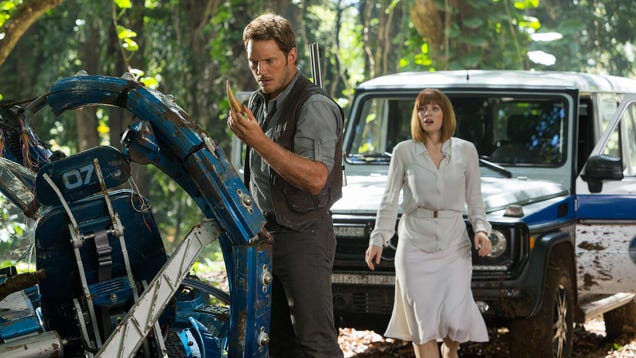
We wanted these dinosaurs to feel like real animals. That’s a theme that we’re very interested in, and certainly pushing forward with this, is to make it not a monster movie. These are living, breathing animals that did once exist on this planet and by resurrecting them, we have made these things un-extinct.
And so I felt like presenting these dinosaurs as something that will just eat you all the time, every time, wasn’t the way to go. I got to the point where, even at the end of the movie, a dinosaur chooses not to engage in battle, with an animal that has been its nemesis every time we’ve seen them together. They always fight. I don’t think it gave them a certain amount of humanity, but I think it gives them an amount of nuance, and hopefully as characters allows us to respect them a little more. And sort of drive our respect for animals, which would be a goal for me.
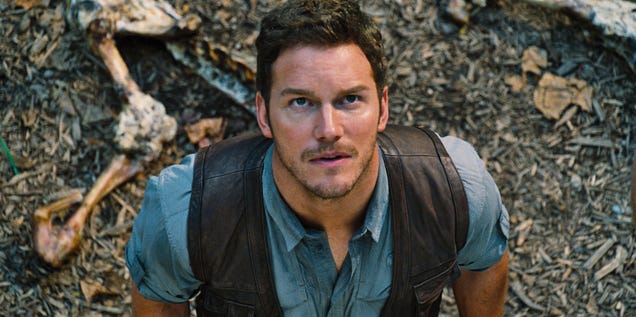
I did notice with the Indominus, you do the classic monster movie thing of showing us glimpses of it, and then slowly revealing it.
That’s because it’s so early in the movie. That would be too early. We wanted to do it just enough so, you know, there’s something inherently engaging about not being able to see the monster, but at a certain point, we knew that we were going to have to unleash it, and ideally because we’re treating the raptors and the T-Rex and these other animals as characters, it allows us to build for a little while.
In a movie that’s sort of a single monster movie, like Jaws, once you see the animal, it identifies the threat and you’re able to start working on ways to take down the threat. I think showing its powers, like any hero, any villain, spending the first half of the movie creating a mythology for it. It’s not Godzilla, where we all know the mythology. We’re introducing a new villain that is a synthetic, in the same way that Darth Vader, and Captain Hook, and Frankenstein all had, like, synthetic elements to them. It’s sort of a “classical villain” trope if anything. Not that I want to engage in tropes, but we know what these things are.

In the same way that in a superhero movie, you spend the first half building up the powers of the hero, he discovers what they are, and then the second half he’s executing those powers. We sort of did they same thing with the villain. By the time you get to the second half of the movie, you know what the Indominus can do. You know what it is. You’ve seen it, and now we’re moving forward.
Actually, did you see Gareth Edwards’ Godzilla? What did you think about that in terms of how it handles this iconic monster?
I thought he handled it really well. I feel like the thing looked beautiful, when you finally saw it. It was such a great effect. I think Godzilla is such an inherently challenging property, and I was just impressed that they were able [to pull it off]. I don’t know if I would have attempted to do it myself, cause I don’t know how the human characters and Godzilla can have a relationship in any way. It makes it really difficult, and that was something that was so important to me. You can see how I work hard to make sure that [a relationship] exists here.
And here the key relationship in a lot of ways is the relationship between Chris Pratt and the raptors, this whole idea of training them, and him being an animal trainer. Where did that develop from?
There was an idea that Steven [Spielberg] had, of a guy who could sort of command raptors in battle and have that human-animal communication. So Derek and I, we tried to dial it back a little bit, to the point where maybe that relationship is just being tested and figured out.
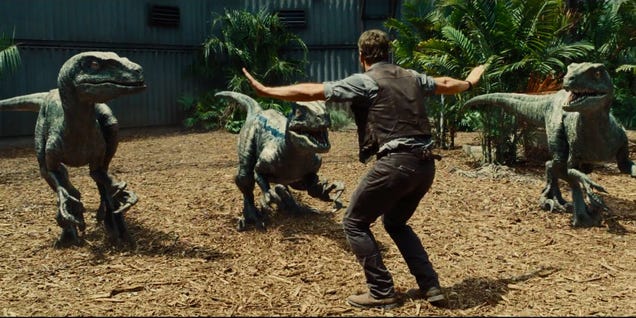
Because that’s something that exists on this planet right now — you have people in Africa who are out in fields with lions, rolling around with tigers and hugging these vicious predators that would kill anybody else and eat them. And so we felt like that’s at least a relationship that people can understand and connect to, and I thought it’s pretty cool when you replace lions and tigers with dinosaurs. And it allowed us to have a relationship that could be tested, because they are predators.
And I thought even though he imprinted on them very young in their lives, it would reach a point where they would have to choose between this human who has cared for them and obviously loves them and something else that is ‘one of them,’ to a certain extent. To have that build up, to be the climax of our movie, to build to that, I feel like that’s an emotional arc that we could rest this whole thing on.
And the theme of nature. In the film, people point out that none of these things are actually natural, in that they’re engineered. And they don’t have any instinct because they’ve been raised in captivity and they didn’t have any parents to teach them. Is the theme of nature vs. nurture something you guys talked about?
Absolutely. There’s a story about a tiger that had been raised in captivity that got loose and just went on a killing spree, like a serial killer. And it killed everything in its path, every living thing that it came upon. And so we based [the Indominus story] on that, and there are examples all over of animals raised in captivity not necessarily having the same psyche, the same mindset as animals that have grown up in a more traditional environment.
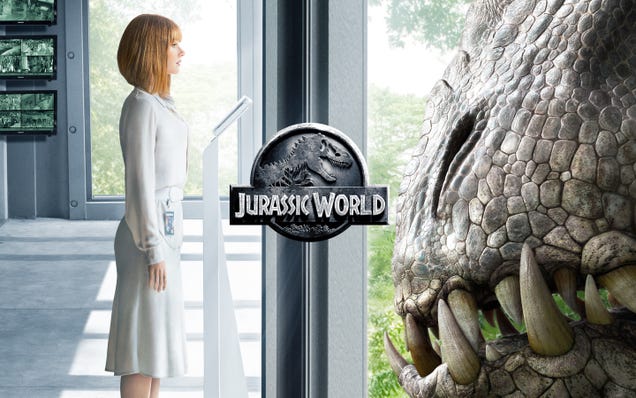
We haven’t seen that in other Jurassic Parkmovies before and I found that the balance of this movie is me trying to make sure that people love these movies and have something that they can feel comfortable with — but also be bold and push it forward and address some new ideas. And that, to me, felt like one of the most salient ideas that we could grab onto.

I know. I mean, look, I had that conversation with her so many times, and she insisted on wearing those heels. They meant something to her personally. She felt like, this is her talking, that those heels were her shield in a certain way as a woman. That’s just how she felt. She felt like surrendering the heels felt like surrendering the femininity of the character, even though women are — I don’t want to say forced to wear heels — but you’re expected to wear heels in certain environments.
And she felt that, even though the image of her running away from the T-Rex in heels is... honestly, maybe I feel that I’m revealing my own ignorance in not having anticipated how that was going to become a subject of discussion, the way that it has. I was thinking about it solely for her comfort, and for logic reasons — the same thing that we’re talking about: ‘Can’t we find some other way? And she’s like, ‘No, no, I’m going to go for it.’
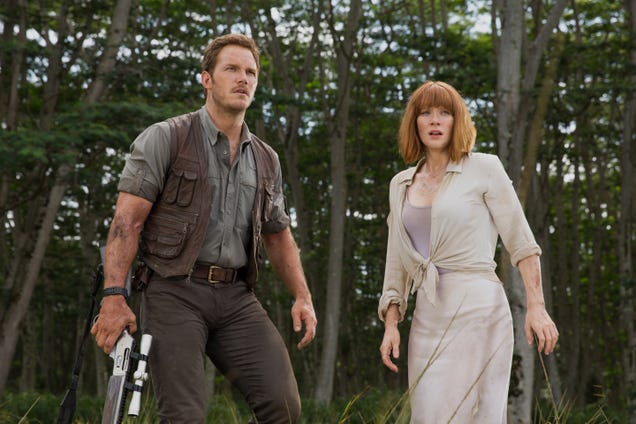
Because that’s something special. I mean, we are talking about it. And these movies, having something that’s iconic to themselves — for better or worse, that’s an image that people are going to remember. [Laughs] And I just hope that it’s recognized that I did bring it up on many occasions. [Laughs] But I support my actors! I want her to feel comfortable. And I want her to create a [character] that is truthful and true to her and how she feels in that character’s shoes, for lack of a better [word]. And that’s what made her feel like Claire.
And these movies aren’t strict realism.
No, but knowing that character, I can buy that character would never take her heels off. She walks around in those heels every day. She’s already in that jungle wearing a white dress. I mean, I think to her it was just true to Claire, even if it’s not true to anybody else.
So what do you think about the criticisms of the gender roles in the movie? At times, Chris Pratt seems condescending towards Bryce Dallas Howard, and that’s mixed in with the romance subplot.
I mean, he is condescending, at points. And that, to me, was designed to focus on our lead character, who is Bryce Dallas Howard. I mean, she’s the hero of the movie, and she’s the one who changes. She goes through a pretty massive arc, from being the head woman in charge and very corporatized, and very much governed by the needs of that corporation, to somebody who has kind of stripped herself of all the trappings, and become very at one with her inner animal — and the natural world. And [she’s] recognized that she saw these animals as assets, and as numbers, and that they are in fact living, breathing creatures. And I found it to be a movie about her finding her humanity. And that’s always how I saw it.
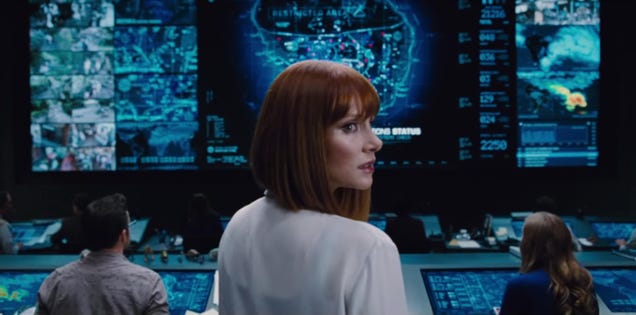
And honestly, I guess it’s a testament to my own ignorance of how things can be perceived — I never really saw it any other way. I definitely didn’t see it as a character who was learning to want to have children. That didn’t even occur to me. Because I don’t see her as going off and having children at the end of the movie — that doesn’t seem like that’s what she’s going to do. But I’ve heard that argument.
And look, it’s hard for me to debate any of those things, because it’s all about perception. It’s all about something lands with somebody. And I feel like everybody is right. However it lands with you, and however you perceive what we’re doing, you’re right. Because that’s how you saw it. So all I can say is, I hope that whatever people see in it, they know I very sincerely was looking to make a real badass action heroine who doesn’t surrender her femininity in the process of being a badass action heroine.
Changing gears... Tim Story, who directed Barbershop and then was hired to direct the first two Fantastic Four movies, has talked about how easy it is for a director coming to big VFX movies for the first time to lose control over the VFX part of the movie and just work with what they give you and get swept along by it. He seems to have felt like maybe he wasn’t entirely in control. Do you think that’s a danger? And how do you deal with that?
It’s a danger. It’s not what happened with me. I was in control of this whole movie, from start to finish. And I don’t have the ability to pass the buck to anyone else — not that that’s what he was doing.
I’m quoting him from memory, so that may not be 100 percent accurate.
But I just don’t have that luxury. Everything you see on the screen was something that I wanted to put there. And I was supported by the studio and by Steven in wanting to put these things on. But it’s my movie. I feel like there’s a certain amount of creative freedom that comes along with that, and that’s very satisfying. But there’s also something taken away from you — you don’t get to say, ‘Oh, this giant corporation made me do all this stuff.’
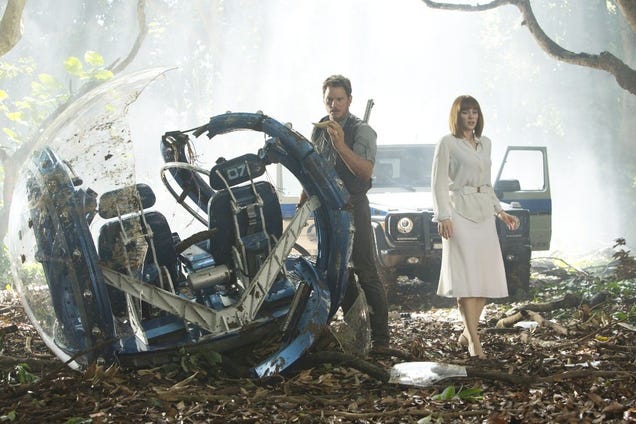
But how do you communicate your vision to the VFX people? They’re showing you animatics and simulations, and how do you shape that?
I’m there every day, and telling them what it’s going to be, and then they’re being creative as well. This is a collaborative relationship, and it’s a fantastic one. I didn’t find any of that. VFX animators and everyone at ILM, and people who do previz — all of these people are there to realize your vision. So if you’re clear with it, and you know what you want, and you articulate it in detail, they can realize anything in your imagination. All of that stuff was a very positive experience for me.
This whole thing, from start to finish — it’s gone very, very well. I am so conscious of the fact that that’s kind of an anomaly. It’s very rare that movies go as well as this. We finished ahead of schedule, under budget [and] didn’t have to do any reshoots. All of the things that very often happen — and [they] don’t always mean that a movie’s going to be bad. Some of our greatest movies have gone through extensive reshoots. And yet, for me as a personal experience, this all went very smoothly, and I’m very grateful for that.
Do you think younger film-makers, who grew up with computer animation, are more comfortable using it as a tool?
We used what was necessary in the moment, to execute whatever the vision was. We did use animatronics. We used motion-capture, which I thought added a certain humanity to the animals. I don’t know...
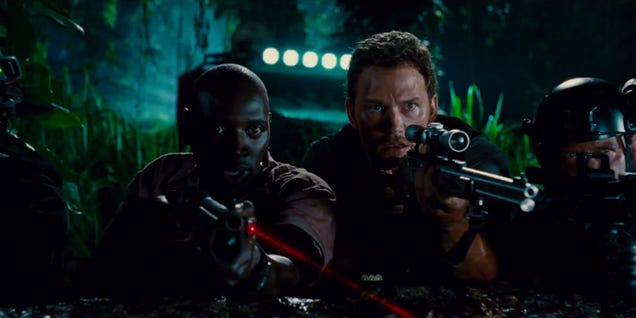
I learned on film at NYU. I was probably the last generation that was analog. Anyone who was a year younger than me, it was probably all digital. I shot [Jurassic World] on film, but my first film was digital. So I’m [not a] digital kid, either. I’m right on the bridge. What’s really interesting about the younger film-makers that came up in that age is, they got to make so many more films. There was no limitation to how much they could do, so they’ve all made a thousand weird little shorts, and they were able to hone their skills, that I’m not sure I ever got a chance to do. I made one short film, Safety Not Guaranteed, and this.
And so, I think being able to have that incubation period is really valuable for a film-maker. To the point where I’m going to go backwards now, and buy myself an incubation period [using] whatever cred I get with this in the business. I’m going to go make a smaller film, and then a medium-sized film, and continue to hone my skills as a storyteller, because I think I have to.
The message in the first Jurassic Park is, “Nature finds a way,” and “Your scientists were so preoccupied with whether or not they could, they didn’t stop to think if they should.” In this movie, is the message all the stuff where people say, “You guys went too far for spectacle. You demanded things that weren’t realistic in the dinosaurs. You wanted bigger and better.” And so on?
Not necessarily in the context of [talking about] movies, specifically — although I know it can be applied to that. It was really more [that] we live in kind of this ‘upgrade’ culture, where we feel very entitled to be entertained and pleased all the time. ‘Give me something more, and then I’m going to hate it.’ [Laughs] ‘Then give me something else, and I’ll hate that.’
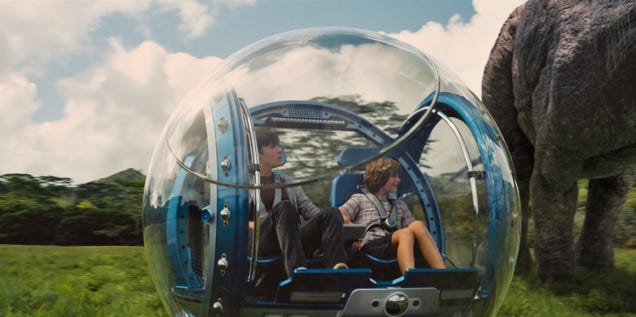
And what I saw in all of that is, dinosaurs are a very humbling presence. And I think just the very idea that you would be in front of something that is that grand and that spectacular, and you would shoot it on your phone — and not have that experience, not have that connection. There’s lot of things [in this movie] about connection, between humans and animals, between humans and each other, humans and ourselves — between brothers — I hope that there’s a humanity in the movie. Or an encouragement of humanity in the face of great corporatization. And it’s not an anti-capitalist movie, or an anti-corporate movie... but there is something dehumanizing in the corporatization of everything.
And we talk about it very early in the movie, how that first [Jurassic] Park was legit, because they just had real dinosaurs. They didn’t have all these genetic hybrids. And I would hope that, yeah, it’s a movie that encourages humans to embrace one of our great gifts: That we’re sentient, and we can fall in love, and we can connect with each other. And maybe that’s all too simple, for a movie that I think asks a lot of big questions and I think handles a lot of big themes, but in the end is a children’s film. And I feel like [it’s] a children’s film about, ‘Hey, let’s all fall in love.’



























